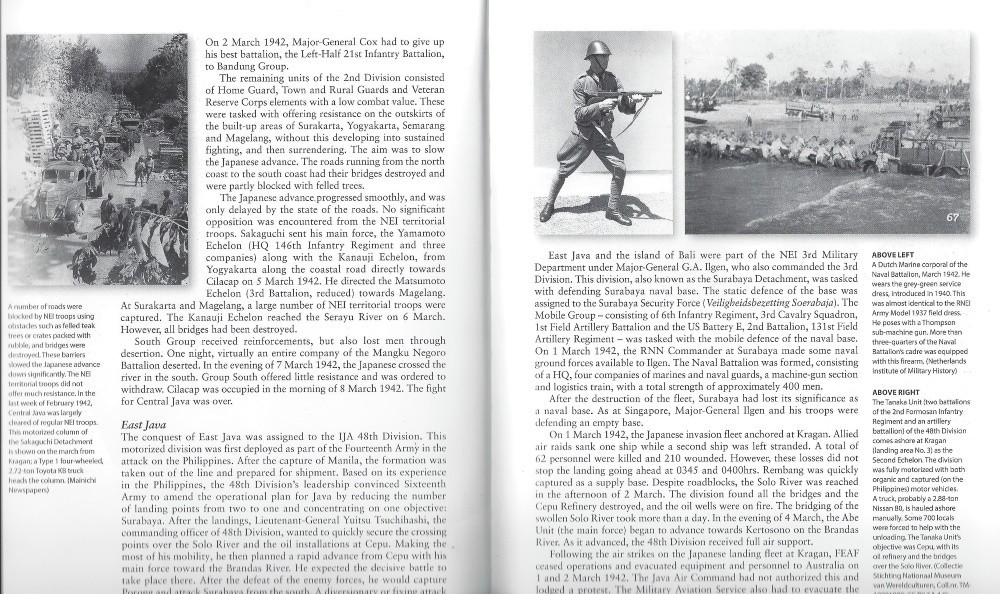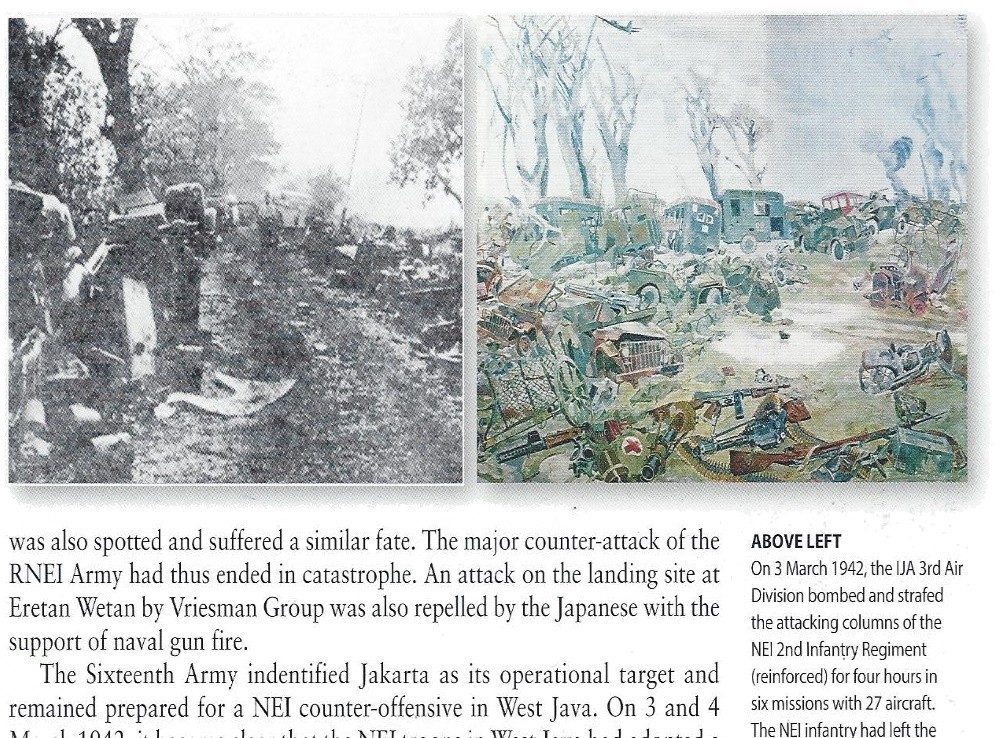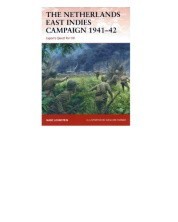
Introduction
Authored by Marc Lohnstein and illustrated by Graham Turner, The Netherlands East Indies Campaign 1941–42 is part of Osprey’s Campaign range, title number 364. Campaign books tend to be some of their longest with 96 pages including the index. They offer unique items like full color battle scenes, three-dimensional bird's-eye views, as well as regular illustrations and my beloved maps. This book is available in softcover, PDF, and eBook. The soft cover is catalogued as ISBN 978-147-284-3524, and with Osprey's short code CAM 364. While Japan was conducting an air-sea-land conquest of the Philippines and Singapore, launching major offensives in China and Burma, with their aircraft carriers rampaged through the Pacific and Indian oceans, they also launched an air-sea-land campaign against the islands of the Netherlands East Indies.
Osprey tells us of this book:
At the end of 1941, Imperial Japan targeted The East Indies in an attempt to secure access to precious oil resources. The Netherlands East Indies Campaign featured complex Japanese and Allied operations, and included the first use of airborne troops in the war. This highly illustrated study is one of the less well-known campaigns of the Pacific War.
Imperial Japan's campaigns of conquest in late 1941/early 1942 were launched in order to achieve self-sufficiency for the Japanese people, chiefly in the precious commodity of oil. The Netherlands (or Dutch) East Indies formed one of Japan's primary targets, on account of its abundant rubber plantations and oilfields.
The Japanese despatched an enormous naval task force to support the amphibious landings over the vast terrain of the Netherlands East Indies. The combined-arms offensive was divided into three groups: western, centre and eastern. The isolated airfields and oilfields were, however, picked off one by one by the Japanese, in the rush to secure the major islands before major Allied reinforcements arrived.
This superbly illustrated title describes the operational plans and conduct of the fighting by the major parties involved, and assesses the performance of the opposing forces on the battlefield, bringing to life an often-overlooked campaign of the Pacific War.
This campaign is particularly interesting to me as there is a personal connection - my dad was on the USS Houston, sunk at the Battle of Sunda Strait.
The Netherlands East Indies Campaign 1941–42 Japan's Quest for Oil
Content
What's inside the covers? On the back of the title page is a key to military symbols, as well as a list of colonial versus modern place names, dozens of them. There's also a note on time as the Netherlands East Indies spanned several times zones. The common format of Campaign books is an explanation of how and why the campaign came to be, timeline, exploration of the opposing commanders, forces, and plans, and the accounts of the actual fighting. The Netherlands East Indies Campaign 1941–42 is 96 pages of information and images organized into these chapters and subsections:
Origins of the Campaign
· Japanese expansion
· Oil: fuel for ships, planes and war
· Moving south
Chronology
Opposing Commanders
· Japanese
· Allied
Opposing Forces
· Japanese
· RNEI Army
· Allies
· Orders of battle
Opposing Plans
· Japanese
· Netherlands East Indies
· Allies
The Campaign
· Phase I operations
· Phase II operations: the conquest of the NEI
· Tarakan
· Mendano
· Balikpapan
· Kendari
· Singkawang
· Ambon
· Makassar
· Banjarmasin
· Palembang (Operation L)
· Bali
· Timor
· Java (Operation H)
· Surrender
· Operation T (northern Sumatra)
Aftermath
Further reading
Index
The author provides a long explanation why Japan launch into this campaign, dealing with Japanese expansion, how Japan went from an ally of the Western Powers in World War I to an enemy, and the Japanese attempt to peacefully secure the Netherlands East Indies (NEI) into what they called the Greater East Asia Co-Prosperity Sphere. It's very interesting the description under the subchapter Oil: fuel for ships, planes and war, which gives a good overview of how much oil was produced by the NEI and why it was essential to Holland, and to the Japanese. Tables support the text with clear data that would require many more pages of text to impart. Text also further discuss the other raw materials and important products available in the Netherlands East Indies.Clearly, this chapter explains why Japan needed the Dutch East Indies in order to fuel their war in China, and prospective war in Manchuria.
Opposing Commanders is six pages in length. The four main Japanese commanders have brief biographies, noting their education, training, previous posts held, how they were perceived by their peers, even including what became of their fate after the war. The Allied commanders include 5 Dutch commanders and one British Brigadier, which receive the same biographical detail.
Opposing forces presents the order of forces, air, sea, and land. It discusses training and strategic and tactical doctrine. This campaign witnessed the fascinating and unique use of airborne troops by both the Japanese Army and the Japanese Navy. It also does not shy away from mentioning Japanese atrocities against civilians and prisoners of war. The NEI military is introduced and explained in good detail, including the naval arm and the air force. It touches upon a severe weakness of the Netherlands East Indies Army and the relationship of the indigenous people with the Dutch, even quoting an American memorandum describing it. The Allied section of this chapter goes into good detail about what eventually integrated American, British, Australian, and Dutch units into what became known as ABDACOM. Effects of living and fighting in the tropical environment are also noted. A revelation for me is that the British had tanks in this campaign. An indication of how large the campaign was is Orders of battle, which takes three pages to list all of the units involved. These Pages include three tables which list the units that comprise the Japanese Southern Army, 3rd Air Force, and Imperial Navy units employed in the campaign. One of the tables list Japanese aircraft names including the type designation, service branch, the particular aircraft and Allied code names.
Opposing plans details the various operational concepts, such as the Japanese counterclockwise advance favored by the army across the various objectives from the Philippines,to islands, through the Netherlands East Indies and British possessions in Malaya. Each Japanese campaign is generally well-known, but fascinatingly the author details the Netherlands East Indies plans to defend their possessions, and how they or modified or changed before and during the campaign. For the Allied section, it reviews staff conferences in 1940 through 1941, the unified command of ABDACOM in 1942, as well as the relationship between the Netherlands and Australia, and other countries that became their allies. I was surprised to find out that the Netherlands East Indies sent a significant air force to Singapore when the war started. The book also reveals conflicting strategies and goals of defense for the Allies that, not surprising, did not always include the NEI.
The meat of the book is the 54 pages of The Campaign. The different phases and the different objectives are covered suitably, and backed up with photographs and even illustrations. The author provides a sub-chapter on each of the dozen Japanese invasion objectives. Japan’s Operation H schedule included 11 separate objectives, including Java and Sumatra. Each of these is covered in its own subsection; some are little more than a couple of paragraphs, some take up pages: Ambon is covered with two and a half pages; Palembang is covered by several pages; Java takes over a dozen to cover. These histories frequently have maps and other illustrations as well as photographs. Troop dispersals, garrisons, air forces, naval forces, all of these are presented. It even mentions difficulties between commands of the Allies. It discusses the military plans for defending particular objectives. The author documents casualties on both sides, even those taken prisoner and executed. Some subjects such as the guerrilla war in Timor are not covered as they are outside the scope of the book.
The chapter Aftermath is just that, and wraps up in overview and summary what happened, and why. It addresses conflicts between the Japanese Army and Japanese Navy over implementation of plans and timetables. Demonstrated strengths and weaknesses of the Japanese and Allied Forces are examined. It also explores the increase in petroleum production in the Netherlands East Indies which fueled the Japanese war effort. For example, one of the captured refineries accounted for a huge percentage of Japan's aviation fuel. However,that was not endless for Japan, and Aftermath explorers what happened later in the war. Also listed are the number prisoners that died in Japanese hands. Additionally, it also explores how Japan failed to convince Indonesia to join its Greater East Asia Co-Prosperity Sphere and created an opposite effect.
The book is well written and organized, and I found it a worthwhile read.
Photographs and Artwork
The photographic component of this book is remarkable in its illustration of different forces of different countries, as well as combat shots, portraits of leaders and scenes with regular infantry. That gives modelers and historians a good look at their kit. Modelers should find inspiring images of subjects to model individually, or incorporate as a diorama, such as an after-battle portrait of Mendonees riflemen who counter-attacked and drove Japanese paratroopers from arefinery; the caption details their uniform and other kit, and also notes that in the background, the refinery is ablaze. There are several combat photographs. Some of them have been around for as long as I've been reading books, but enjoyably there are many that are new to my eyes. (Not that I've read every single book ever written, of course.) Many of the photographs are excellent, well-lit, sharply focused, illustrative of great detail. Obviously, some are amateur grab shots. Several photographs are taken from reconnaissance planes, giving a lay of the land. Some of the photographs of commander's tend to be grainy. I cannot think of a photograph though that is not useful to supporting the text. Some of the photographs are not photographs, they are reproductions of Japanese wartime artwork. My only complaint is that almost all photographs are relatively small, perhaps two inches along the longest side. And yet the printing process is good, printing in great quality so the photographs are easy to glean information from.
Artwork
Artist Graham Turner created original artwork specifically designed for this book. That includes full color battle scenes, three-dimensional bird's-eye views, and maps.
1. Map: The Netherlands East Indies - stretching from Burma to the middle of New Guinea, and northern Australia to the north of the Philippine.
2. Split map: Southern Army Operational Plan and the Iwakuni Agreement: the Southern Army Operational Plan versus the Iwakuni Agreement (Operational 14th and 16th Army with Third Fleet). This spans from deep in China, east to Japan, south to northern Australia, thence west to below the center of Sumatra. Army units are shown with red arrows depicting Japanese movements.
3. Map: RNEI Army locations. This map shows the Netherlands East Indies divided into 10 sectors, listing 10 associated Netherlands East Indies troop strengths and commands. Peacetime and wartime strengths are listed, as well as defensive lines and territorial commands and military districts.
4. Map: Japanese Southern offensive: detailing Japanese movements and Allied movements, listing units, with dates of landings. A caption describes and explains the map.
5. Two-page battle scene: Attack on NEI Strong Point Number 10, Eastern Front, Tarakan, 11th January 1942. Those strong points were defending an oil field and depicts Japanese troops running through a field towards the burning oil field into NEI fire. Six specific events are keyed.
6. Bird's-eye view: The Japanese Assault on Menado, 11-12 January 1942. This interesting three-dimensional map is keyed to 13 events, listing Japanese commands of three Japanese landing forces, and 11 Allied companies and detachments.
7. Bird's-eye view: The Japanese Assault on Ambon, 31 January-3rd February 1942: keyed to 19 combat events, 15 Allied combat units, 6 Japanese combat units. Routes of march are depicted.
8. Map: Operation L: the Attack on Palembang: identifying Japanese and Allied movements, territorial command boundaries, roads, swamps and marshes.
9. Two-page combat scene: Netherlands East Indies Counter-Attack at Palju Refinery, Palembang, 14th February 1942. This artwork illustrates Menadonese soldiers armed with swords, rifles and other infantry weapons charging Japanese paratrooper positions in a burning refinery.
10. Map: Operation H: the conquest of Java - split map showing West Java and East Java, illustrating Allied and Japanese units, arrows showing movements, road networks and major towns. This map is also accompanied by a narrative that describes terrain, population of the island, and other information.
11. Two-page bird's-eye-view The NEI Mobile Unit Attacks into Subang, 2 March 1942. This is keyed to 11 important events and encounters, with Dutch tanks charging through a Japanese-held-village.
12. Bird's-eye-view: Japanese Breakthrough at Ciater Pass, 5-7 March 1942. Keyed to 10 events, listing two Japanese detachments and 15 Allied combat units.
I do not consider the aforementioned Japanese wartime paintings to be artwork because they are not original for this book and are used as in lieu of a photograph.
Tables
1. Japanese oil supply 1937 through 1939 (millions of barrels), includes consumption, Japanese production, the amount imported, imported from the United States, the Netherlands East Indies, and other sources.
2. Netherlands East Indies oil industry (millions of barrels), with the same years, and how much was produced in various areas, as well as how much was exported to Japan specifically and throughout the world in general.
3. Comparison of weapons: Infantry regiment, Japanese standard division; Infantry Regiment, RNEI Army:
· Strength (personnel)
· Horses
· Rifles or carbines
· Sub machine guns
· Light machine guns
· Grenade dischargers
· 81mm mortars
· Medium machine guns
· Heavy machine guns
· Machine cannons or 20mm anti-tank rifles
· 37mm and 47mm anti-tank guns
· 70mm battalion guns
· 75mm regimental guns
4. Detachments: Japanese Detachments A-I and its alternative name, parent unit, campaign involvement, and objective.
5. Japanese aircraft names by type designation, service branch, aircraft, Allied code name.
6. Royal Netherlands Navy personnel in the NEI, 1940, showing the category (officers, petty officers, seamen, etc.) and quantity of each.
7. The schedule for Operation H: the Tokyo Agreement: date of landing; key objective; assembly point.
8. Japanese operational codenames: Operation A-Go through Operation Z, listing offensives, e.g., Southern Offensive, British Borneo, Philippines, northern Sumatra invasion.
9. Operation H schedule: the Cam Ranh Agreement: timetables of the Tokyo Agreement at the start of the war and the following Cam Ranh Bay Agreement, with start dates, key areas to capture.
10. Troop strengths of the Japanese 16th Army, RNEI Army and Allies, by the area of operations.
11. Allied POW numbers by military branch and country, per Red Cross report compared to Senshi Sosho.
12. Petroleum production in the NEI: April 1942to VJ-Day:
· Production in million tons
· Production by million barrels
· Export to Japan
The text is certainly enhanced and improved by that visual gallery.



Conclusion
Japan’s tsunami of conquests in the first several months of the war are almost as unbelievable now as they were shocking in 1942. The Netherlands East Indies Campaign 1941–42, Japan's Quest for Oil recounts that chapter of that epic offensive. It is well written, presents good detail, and is well illustrated. This book is an excellent companion for other Osprey books: Java Sea 1942; Malaya & Dutch East Indies 1941-42: Japan's air power shocks the world; Rising Sun, Falling Skies; Sinking Force Z 1941; Malaya and Singapore 1941–42, to name a new. It would not surprise me if the future sees those titles compiled and published in a large hardback book such as Osprey has done with other related titles, i.e., D-Day, Japanese Navy, Luftwaffe.
As model companies continue to release new mainline kits of previously niche subjects, this book may become a reference resource when specific subjects are kitted. Until then, it can be an inspiration to build kits available today of the many of aircraft, ground vehicles, naval vessels, and ordnance subjects that participated in this campaign. It has been a great read and I happily recommend it.
Please remember to mention to Osprey and retailers that you saw this product here - on Armorama.



























